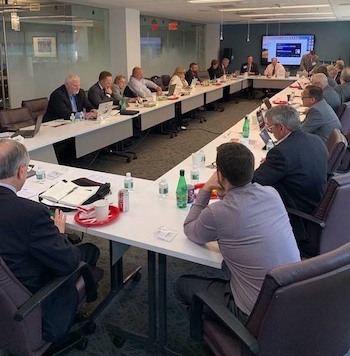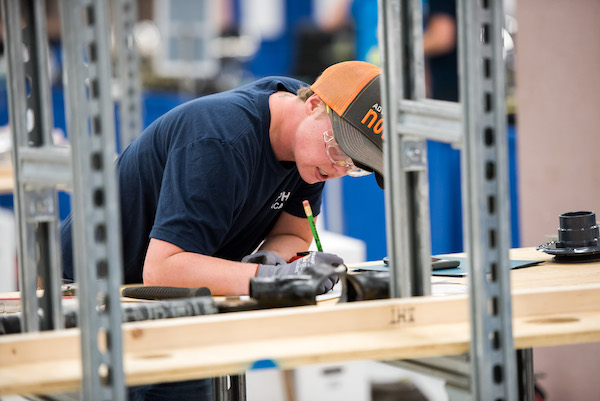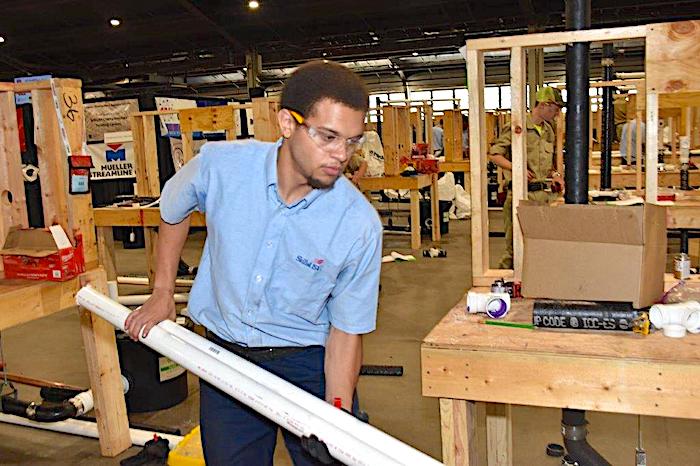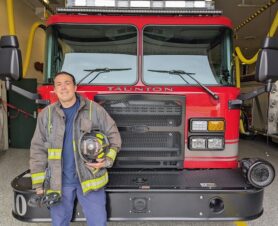
The PILC meeting in DC.
Back in late spring, I had the chance to attend the annual Plumbing Industry Leadership Coalition (PILC) meeting to discuss current issues facing the plumbing industry. PILC is mainly comprised of the largest and most influential associations, professional societies, nonprofits and third-party certification bodies representing manufacturers, laborers, contractors, engineers and water efficiency experts.
The efforts of this group have been very successful, and its message and action items are heavily advocated on Capitol Hill. Successful past campaigns have seen the extension of the WaterSense program, and a Drainline Transport study to exemplify the unintended consequences of water efficiency. In terms of low-flow fixtures combined with plumbing design (slope, water flow, stagnation) in commercial buildings, the question is, how low can you go? The in-depth study revealed that at the current flow rates, no change is imminently needed, but if we continue to go lower, perhaps a new investigation would be in order.
Guest speaker, Dr. Greg Allgood, World Vision, talked about the global water crisis and said that 1,000 kids die every day around the world due to unsanitary water conditions, yet people aren’t outraged anymore because it happens so often. We’ve become desensitized, or perhaps we take a Not in My Backyard (NIMBY) view. Interestingly, according to Allgood, “844 million people don’t have access to a clean water source near their homes.”
World Vision provides safe drinking water to an average of one person every 10 seconds. For example, the organization is currently working on a project that seeks to ensure that 100% of the inhabitants of Rwanda have access to improved water resources. Dr. Allgood expressed a desire to work closer to the plumbing industry.
Action Items
The PILC meeting had its share of action items. The Alliance for Water Efficiency’s Mary Ann Dickinson is working to create a tax exemption status for consumer incentive rebates on water efficient products.
PILC is also seeking input for the development of the National Water Reuse Action Plan. According to PILC, “Federal leadership is sorely needed to help ensure that, as we go forward with utilizing this critically important resource, we make sound, scientifically based decisions that work to prepare our country for the successful utilization of all alternate water sources.”
In order to protect public health and safety as we embark on this collective effort, says PILC, it will be critically important to develop and build on a strong foundation, beginning with the establishment of common terms and definitions for the various alternate water sources.

Workplace development is critical.
Currently, alternate water source terms and definitions are being developed in technical silos. Some terms have been generally well defined and are adequately descriptive of the water source. However, other terms, especially those utilizing various colors, such as graywater (greywater) and blackwater, fail to communicate an adequate level of technical accuracy or a reasonable description of the resource that would allow for a clear public understanding.
Concern arises in that terms that were once considered appropriate now convey inappropriate connotations. The term “wastewater,” for example, was appropriate for a time when the goal was to simply separate water used for any purpose in a building from the building occupants as quickly as possible through the building’s sanitary system. In an age where we now seek to convey to the American public that this water is a valuable resource that needs to be carefully treated and reused efficiency in order to help secure our Nation’s water future, this term is clearly outdated and counter-intuitive.
In addition to the terms “blackwater,” “brown-water” and “yellow-water” being inadequately descriptive of the resource, they have potential to reinforce negative stereotypes about people of color. The use of color descriptors for water that is considered a public health risk could be seen as reinforcing a culture where the colors are associated with “bad” versus “good,” which runs counter to the fact that all alternate water supplies can be put to beneficial end uses.
To begin the process of developing a consensus-built terminology for water reuse, PILC suggests the use of an in-person expert workshop to develop terminology and definitions.
Workplace Development
Finally, and perhaps most important, in my opinion, was the topic of workplace development. A task group will be established to focus on how best to reach out to “Generation T” with messaging and career opportunities in the plumbing industry. “Marketing and messaging need to be more poignant.”
Interestingly, I was a surprised to see that not everyone in the room that day thought that workplace development was of major concern. When I arrived back to my office, Michael Copp, executive vice president, Plumbing-Heating-Cooling Contractors-National Association (PHCC), and I discussed this issue with a bit more urgency. When asked, Copp said, “Workforce challenges are not the same across the country and across industry sectors. In general, though, according to the Bureau of Labor Statistics (BLS), the economy will resume a growth rate of 2.5% and construction starts will remain virtually unchanged ($808 billion) in 2019. The number of plumbing and HVAC companies will grow by 1.8% and 2.6% respectively. For every four jobs that are vacated, the industry is only filling one. According to the Bureau of Labor Statistics (BLS), there were 480,600 plumbing jobs back in 2016, with positive growth expected for the next 10 years.”

According to Copp, by the end of 2020, more than 50% of businesses entering the construction industry will be minority- or female-owned. He says that we need to reestablish vocational education that was dismantled in much of the country. We need to achieve greater diversity within the skilled-trades industries to include more women, minorities and at-risk youths: all seeking that same level of importance and respect applied to their contribution to society.
According to BLS, “Employment of plumbers, pipefitters, and steamfitters is projected to grow 16% from 2016 to 2026, much faster than the average for all occupations.”
According to Copp, while the narrative is slowly changing from “College Readiness” to “Career Readiness,” we have to overcome what has been a cultural norm in which “For two or three generations, the focus has been to go to college, get a degree and in doing so you will ensure a brighter future with more access to employment,” (Joshua Wright, America’s Skilled Trades Dilemma: Shortages Loom As Most-In-Demand Group Of Workers Ages, 2013).
“We need a movement,” says Copp, “a cultural shift in which parents, guidance counselors and others do not view vocational skilled-trades education/ apprenticeships as a second option to going to college. With the right policy reforms and resetting national priorities, skilled- trade education can lead to additional education and career advancement. The Department of Labor reported on September 21, 2016 that, “Today, 91% of apprentices remain employed after completing their programs, with average annual starting wages above $50,000. The return on investment for employers is substantial, as studies indicate that for every dollar spent on apprenticeship, employers receive average of $1.47 return in increased productivity.”
Copp says that we need to reestablish vocational education that was dismantled in much of the country. “We need to achieve greater diversity within the skilled trades industries to include more women, minorities and at-risk youths—all seeking that same level of importance and respect applied to their contribution to society. We must overcome stereotypes, and starts with better messaging.”



